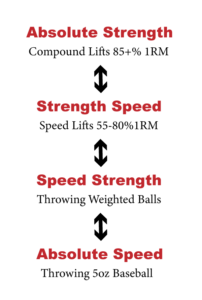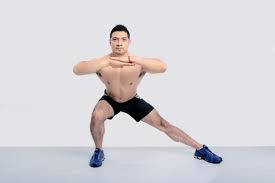All great athletes have a desire to improve, and they have a sense of urgency about it. One of the keys to consistently progressing throughout your athletic career is balancing that sense of urgency with patience. This is especially important for beginners. Many beginners want to move onto the “fun” training modalities like throwing weighted balls and velocity-based training, but it’s important that they build a stable base of fitness first.
Strength is Huge
When young athletes come to train with me, they’ve basically spent all of their time playing their sport or sports and little or no time in the weight room. This means that they’ve spent nearly all of their time at the absolute speed end of the absolute strength-absolute speed continuum.
By bringing them to the opposite end of the spectrum and spending some time there, we often see improvements in their sport specific movements (speed, agility, etc.) without specifically training those things.
Improving absolute strength allows the athlete to produce more force and will provide the base required to improve athletes’ power and other aspects of the absolute strength-absolute speed continuum (less force, higher velocity). Keeping it simple and getting strong before moving onto more novel approaches, like velocity-based training, will make those approaches more effective once the athlete is ready.
Movement Variety and Quality
Movement quality should be prioritized, as it will lay the groundwork for all future improvements. Learning how to move well at a young age is much easier than having to correct issues later and makes adding weight and speed easier down the line. This means learning how to squat, hip hinge, lunge, push, pull, and organize and stabilize the spine.
Movement variety is also important at this point of athletic development as it may help athletes become more adaptable and injury-resistant as they progress in their athletic career. If athletes play only one sport, this becomes even more critical, because they are relying on their training plan to provide the necessary movement variety they won’t be getting from playing multiple sports.
It’s also important that athletes move through all planes of motion — sagittal, frontal, and transverse. While many of the movements we perform in the weight room are done in the sagittal plane, sports occur in all planes. Athletes must be able to produce and accept force quickly in games, and in order for this to be done safely, they must have done this in training prior to game day. Squats and deadlifts (sagittal plane) are great, but moving laterally (frontal plane) and rotating (transverse plane) are also important for elite sport performance.
Keep it Fun(ish)
Too many athletes see training as a punishment, or something they have to do, rather than a privilege and opportunity to get better. Adding competition and game-like scenarios to training when possible can help make training more fun.
Not all parts of training can be the most fun things in the world, but if the environment is kept fun and the coach doesn’t act like a drill sergeant, athletes are more likely to buy in and train long-term.
As a young athlete or coach of young athletes, keep training simple with these three principles, and you have a great opportunity for long-term success.


